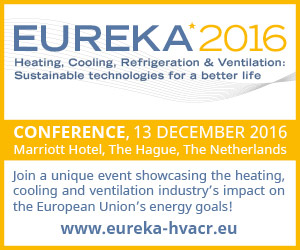EC calls for flammability standards review
11th December 2016EUROPE: The European Commission sees current flammable refrigerant standards as a barrier to low GWP alternatives and recommends that these should be urgently addressed.
 The new Commission report is based on responses from 24 member states and is due to be published on January 1. It concludes that flammable refrigerant standards at international, European and national level appear to be a major barrier to the uptake of these climate friendly alternatives to HFCs.
The new Commission report is based on responses from 24 member states and is due to be published on January 1. It concludes that flammable refrigerant standards at international, European and national level appear to be a major barrier to the uptake of these climate friendly alternatives to HFCs.
In particular, the European Commission report sees a need to maximise charge sizes without compromising safety as well as allowing a more general use of risk management approaches for all refrigerants.
“To facilitate the achievement of the EU HFC phase-down and emission reductions in the EU and third countries as required by the Paris Agreement in the most cost-efficient way, these barriers should be addressed with urgency,” the report says.
The most relevant standards for refrigeration, air conditioning and heat pumps are EN 378, as well as the product standards IEC EN 60335-2-40 (for air-conditioning systems) and IEC EN 60335-2-89 (for integral and remote commercial refrigeration appliances). These take precedence over EN 378 but EN 378 has just recently been revised. Its parallel standard at the international level is ISO 5149. At international level, amendments to standards IEC 60335-2-40 and IEC 60335-2-89 are currently being discussed in the relevant IEC committees.
Restrictions
No member states reported any significant national restrictions on CO2 or ammonia in air conditioning and refrigeration that went beyond European requirements – although some stakeholders identified some restrictive rules on ammonia use in France. However, the same could not be said for flammables, whether highly flammable A3 hydrocarbons or the “mildly flammable” A2L HFOs.
A number of national decrees were identified in Italy, France and Spain that severely restrict the use of flammable refrigerants in air conditioning equipment in certain types of public access buildings. These requirements are said to go well beyond European and international standards.

In Sweden, additional risk assessments are required for the use of flammable refrigerants, which respondents claim can lead to additional time and cost constraints.
Local building codes and fire regulations, as well as transport and storage-related codes, exist in a number of member states. These, again, can severely restrict the use of flammables.
The report claims that restrictions are inconsistently applied across national territories. In federal states barriers may exist at lower levels of government that are difficult to identify and address.
Some codes at a regional or local level can be unnecessarily strict, and rules applied locally by safety authorities often leave room for interpretation, which can hinder the widespread use of flammable refrigerants.
Germany reported that national rules for hydrocarbons are actually less restrictive than the standards at European or international level. However many end-users prefer following the more restrictive European standards.
The report calls for European standards organisations to facilitate the update of relevant standards and encourages all stakeholders to contribute. It also asks all member states that have restrictive national codes, standards or legislation to consider a review in the light of technical developments that would allow the safe use of alternative refrigerants.
EN378 update
Limiting the equipment charge size is currently the main way of minimising risks of flammable refrigerants. EN378 limits charge sizes but the recent revision to the standard introduces a new flammability category for HFCs and HFOs. This is expected to extend the use of these A2L refrigerants by allowing larger refrigerant charges if certain risk management measures are put in place or considered in the design of the equipment.
While these revisions go some way towards easing the use of HFOs, significant barriers are said to remain for the use of hydrocarbons.
The European Commission report sees EN378 as being unnecessarily restrictive in setting charge sizes for hydrocarbons that go beyond what is needed to guarantee safe use of the equipment. It maintains that risk minimisation in system design and use are not sufficiently considered for all flammable refrigerants to determine safe charge size.








